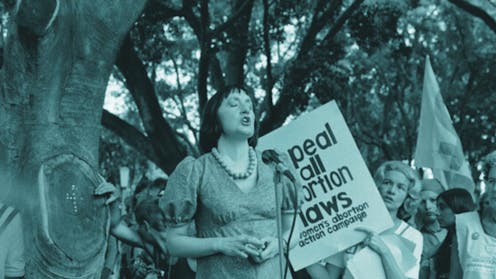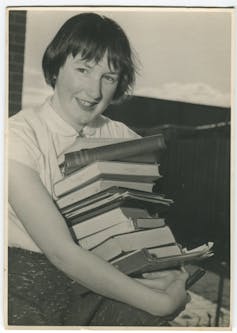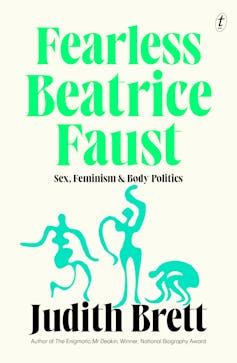Detta inlägg post publicerades ursprungligen på denna sida this site ;
Date:
Author: Michelle Arrow, Professor of History, Macquarie University
Original article: https://theconversation.com/feminist-reformer-beatrice-faust-was-a-sexual-libertarian-who-did-her-homework-kept-her-cool-and-criticised-wimp-feminism-255010

Beatrice Faust was an iconoclastic public intellectual. I first encountered her through her columns in the Weekend Australian in the 1990s. She was by then a standard-bearer for second-wave feminism, at a time when public conversations about feminism were defined by inter-generational conflict.
She was also a brilliant, strategic activist. Her brainchild, the Women’s Electoral Lobby (WEL), transformed Australian politics. She could be bossy: at the inaugural Sydney meeting for WEL in 1972, she was asked “why is it that you are always right?” Bea (as she was known) later told a friend that she replied, “because I do my homework and keep my cool”…
Those are words to live by.
Review: Fearless Beatrice Faust: Sex, Feminism and Body Politics – Judith Brett (Text Publishing)
Faust devoted her energies to many different activities. She was an aspiring academic, a political activist, a reformer, a creator of organisations, a writer and public thinker. Anchoring one’s subject in their social and cultural context is one of a biographer’s key challenges, and Judith Brett’s Fearless Beatrice Faust: Sex, Feminism and Body Politics meets this challenge, and more. This is a frank, psychologically rich biography.
Brett explains that this project came about after Bea’s death in 2019, when a group of her friends decided that the founder of the Women’s Electoral Lobby deserved a biography. Yet what emerged in Brett’s research was that WEL was just one achievement in a restless, energetic life. Brett hopes her book might encourage younger women to engage with Faust, and gain “a deeper understanding of the experiences and debates that created the feminism and sexual politics they inherited”.

Text Publishing
Brett begins with an evocative picture of Bea’s grim childhood, as the anxious child of a mother who had died in childbirth. Bea was beset by chronic asthma and the absence of maternal love defined her emotional life. Yet she was clever, and she bloomed at the Melbourne selective school, Mac.Robertson Girls’ High School. Determined to escape her bleak home life, she won a residential scholarship to the University of Melbourne in 1957.
As Brett notes, Bea was part of a pre-baby Boomer generation of middle class girls raised to a life of twinsets and pearls who remade their lives: “brought up under one structure of feeling, these women created a new one”. University helped provide a road-map for a different kind of life, even as she married, divorced and gave birth to her only son, Stephen.
‘Body politics’
Bea was a lifelong advocate for abortion law reform and it was this issue that drew her into activism, first as part of the growing civil liberties movement of the 1960s, and then as a cornerstone of second wave feminism. Bea came of age in the heyday of civil liberties, and she took on its key tools in her subsequent feminist activism: asking uncomfortable questions, presenting facts, advocating reasoned arguments.
What Brett calls Faust’s “body politics” were shaped by her own experience of chronic illnesses (asthma and arthritis in her spine) but also her keen awareness of the devastating impact of unplanned pregnancy, and the risks pregnancy posed to women like her own mother. These experiences also informed her belief that the differences between men and women were not just produced by social conditioning (as women’s liberationists contended) but were, in part, based on biological differences.
Bea’s sexuality informed her politics, too. She was unusually frank about it, claiming to have had orgasms from the age of three, and described herself as having a “masculine” sexual style. She was easily able to separate sex from emotions and was aroused by visual imagery. Her later writing about sexuality, particularly on pornography and paedophilia, would later place her at odds with many feminists.
Faust claimed some impressive tactical victories in the 1970s. Her role establishing WEL was the most famous, invigorating a reforming, rather than revolutionary strand, in Australian feminism.
WEL aimed to find out the positions of political candidates on issues of concern to women and to publicise them in the lead up to the 1972 federal election. The candidate survey both trained women in political activity and drew attention to women’s issues, and it made a huge splash in the election. It’s arguable whether Gough Whitlam would have appointed a women’s affairs advisor (a world first) without the pressure WEL applied.
Faust remained close to WEL even though she moved onto other activism shortly after its establishment. WEL has existed ever since, perhaps not as powerful as it once was, but still issuing election scorecards and acting as an important advocacy group for women.
Faust was a committed advocate for abortion law reform but this proved far more difficult. Brett deftly explains the complexities of abortion politics in the early 1970s, pointing out that pro-abortion advocates were outmanoeuvred by anti-choice group Right to Life in the federal parliamentary debate over abortion in 1973. Body politics had the capacity to energise not just feminists, but their opponents, too.
Faust’s energy as an activist and thinker is even more remarkable in the context of her lifelong physical and mental ill-health, including suicidal thoughts and dark moods. Her chronic pain led her to inadvertently become addicted to the tranquiliser benzodiazepine, the subject of one of her final books, Benzo Junkie, in 1993.
Her unhappy childhood left a shadow over her life that was never fully resolved, though she developed a strong interest in psychology in an effort to understand it.
Bea was also a writer, a thinker and a public intellectual, who ranged widely and never shied away from expressing controversial views: she believed she earned her AO in 2004 for her ability to “say the unsayable”. Brett observes that Faust’s 1981 book Women, Sex and Pornography sidestepped feminist arguments about whether pornography was degrading to women or incited sexual violence, instead investigating what women’s lack of interest in porn might tell us about gender difference.
Faust’s libertarian views on sexuality also informed her perspective on paedophilia. Brett treads carefully and sensitively here. Bea argued that children below the age of consent could have sexual desires (as she herself had) and that many children, especially boys, were unharmed by sexual experiences with adults.
As Brett points out, Faust almost entirely discounted the harms that abuse could inflict and failed to see the inherent power imbalances in the “relationships” she described. It makes for uncomfortable reading.
Wimp feminism?
By the 1990s, some of the feminist movement’s shine had worn off for younger women, who were increasingly reluctant to describe themselves as feminists. While this intergenerational conflict exploded in the wake of Helen Garner’s The First Stone in 1995, Faust anticipated it with her short book Backlash? Balderdash! Where feminism is going right (1994).

Text Publishing
She proudly recounted the achievements of the second wave and took aim at what she saw as the “wimp feminism” of younger women, who she felt were choosing victimhood over agency. Faust resisted victimhood in her own life and she expected other women to do the same.
Bea Faust was fortunate enough to make her living as a public intellectual in late 20th century Australia. There were many media outlets available for a smart woman with bold opinions, which Faust had in spades. This biography is also a history of a rich period of Australian intellectual culture, though with the benefit of hindsight, it is easier to see that many of these spaces were dominated by white men. Bea’s bold, at times even reckless views might have been modulated in a less combative, less masculine public sphere.
I had only one quibble with this marvellous, lucid book. I’m normally a fan of W.H. Chong’s sharp cover designs, but I’m not sure the cover of Fearless Beatrice Faust quite does it justice. Inside, there’s a wonderful photo of Bea speaking at an abortion rally in Sydney in December 1975. She’s in full flight, eyes closed, wearing a dress she made herself. It would have made a stunning cover for this bold and piercing biography.
![]()
Michelle Arrow receives funding from the Australian Research Council.